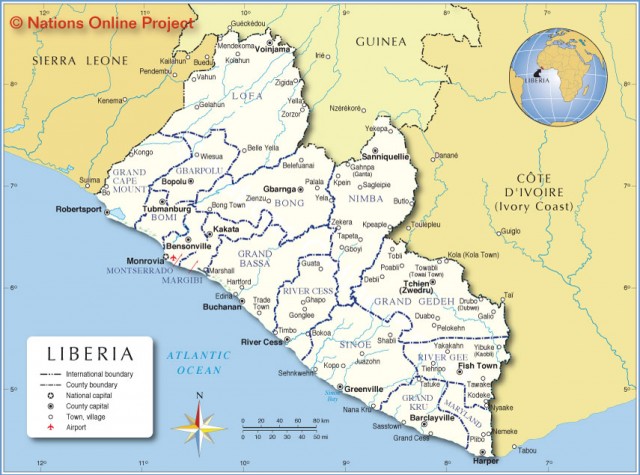Liberia
Area 43,000 sq. mi. (111,370 sq. km)
Population 4.397 million (2014)
Capital Monrovia
Highest Point 4,540 ft (1,383 m)
Lowest Point 0 m
GDP $2.027 billion (2014)
Primary Natural Resources rubber, coffee, cocoa, timber.
LIBERIA, “LAND OF THE FREE,” in western Africa, borders the north ATLANTIC OCEAN, between COTE D'IVOIRE and SIERRA LEONE. It has 10 to 50 mi (16 to 80 km) of flat coastal plain that contains creeks, mangrove swamps, and lagoons. Beyond that, forested hills, from 600 to 1,200 ft (180 to 370 m) high cover the rest of the country, excluding the mountains in the northern highlands. The maximum peak in the Nimba Mountains is 4,540 ft (1,383 m). Six principal rivers flow to the ATLANTIC OCEAN.

Vegetation is predominantly forest, and the tropical, humid climate sees rainfall averages of 183 in (465 cm) on the coast and 88 in (224 cm) in the southeast. The dry season (harmattan, December and January) splits two rainy seasons. Cities other than Monrovia are the ports of Harper and Buchanan.
POPULATION GROUPS
There are 16 ethnicities in Liberia, including the Kpelle, Mano, Baso, Grebo, Kru, and Vaj. Seventy percent are native, traditional religion practitioners, while 20 percent are Muslim and 10 percent Christian. Although English is the official language, the native languages are used commonly. The Americo-Liberians, a minority residing in the cities, tend to be Protestants. Other population groups include Lebanese merchants and European and American technicians.
Liberia was founded in 1820 on the Grain Coast; it was the gift of the American Colonization Society, which received it from the Cape Mesurado chiefs. The founders fought bloody battles with the indigenous peoples. Eighty-six freed slaves from the United States established Christopolis, later Monrovia, in February 1820. Approximately 15,000 freed slaves emigrated from the United States until the American Civil War. In 1847, Liberia declared itself an independent republic. Until 1980, the Americo-Liberian or True Whig Party (TWP) ruled Liberia. The first president was Joseph Jenkins Roberts, American-born. The government and constitution were modeled on that of the UNITED STATES. The republic traded with other parts of West Africa, but it modeled its style of living on those of the United States.
Modernization efforts led to a crisis of foreign debt in 1871. Conflicts with FRANCE and Britain led to losses of territory in 1885, 1892, and 1919. Liberia used the European rivalries and the support of the United States to remain independent. Still its exports declined and its debts rose, leading to foreign interference. Bankruptcy came in 1909. International loans saved Liberia. In 1926, Firestone, the American tire company, leased large rubber plantations. In 1930, the League of Nations investigated charges that Liberia was exporting labor, that is, engaging in the slave trade. The president resigned.
The new president, William Tubman, opened the country to international investment, allowed indigenes greater participation, and allowed the exploitation of iron and other minerals. Education, roads, infrastructures, and healthcare were improved. Tubman died in 1971. His vice president, W.R. Tolbert took over. A proposed increase in the price of rice in 1979 set off rioting.
The TWP's rule ended on April 12, 1980, when Master Sergeant Samuel K. Doe, a native Krahn, pulled off a successful coup. Doe's forces executed Tolbert and several other Americo-Liberians. Doe's People's Redemption Council promised a return to civilian rule, then began repressing the opposition and abusing human rights. Doe instituted constitutional changes, survived numerous coups, and saw flight of thousands of refugees to the Cote d'Ivoire. The refugees returned in 1989, led by Charles Taylor. The war waxed and waned until finally in 2003 the Taylor regime ended, and the country and government struggled to maintain the uneasy truce.